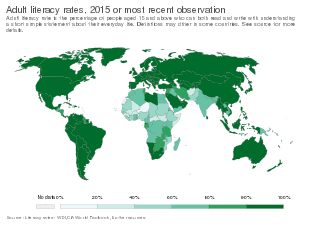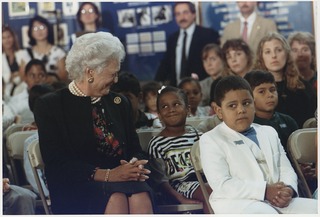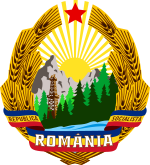
Literacy in its broadest sense describes "particular ways of thinking about and doing reading and writing" with the purpose of understanding or expressing thoughts or ideas in written form in some specific context of use. In other words, humans in literate societies have sets of practices for producing and consuming writing, and they also have beliefs about these practices. Reading, in this view, is always reading something for some purpose; writing is always writing something for someone for some purpose. Beliefs about reading, writing and their value for society and for the individual always influence the ways literacy is taught, learned, and practiced.

Education in the Soviet Union was guaranteed as a constitutional right to all people provided through state schools and universities. The education system that emerged after the establishment of the Soviet Union in 1922 became internationally renowned for its successes in eradicating illiteracy and cultivating a highly educated population. Its advantages were total access for all citizens and post-education employment. The Soviet Union recognized that the foundation of their system depended upon an educated population and development in the broad fields of engineering, the natural sciences, the life sciences and social sciences, along with basic education.
Functional illiteracy consists of reading and writing skills that are inadequate "to manage daily living and employment tasks that require reading skills beyond a basic level". Those who read and write only in a language other than the predominant language of their environs may also be considered functionally illiterate. Functional illiteracy is contrasted with illiteracy in the strict sense, meaning the inability to read or write simple sentences in any language.

Likbez was a campaign of eradication of illiteracy in Soviet Russia and the Soviet Union in the 1920s and 1930s. The term was also used for various schools and courses established during the campaign. Nowadays, this term is sometimes used in Russian as a slang for teaching an unprepared audience the basic concepts of any science, process or phenomenon.
Education in Iraq is administered by the Ministry of Education.
Mission Robinson is one of the Bolivarian Missions implemented by Hugo Chávez in 2003.
The Nicaraguan Literacy Campaign was a campaign launched in 1980 by the Sandinista government in order to reduce illiteracy in Nicaragua. It was awarded the prestigious UNESCO Literacy Award. There have been many other literacy campaigns in the country since the first one was launched in 1980.
"Each one teach one" is an African-American proverb. It has been adopted as a motto by many organizations.

Literacy in India is a key for social-economic progress. The 2011 census, indicated a 2001–2011 literacy growth of 97.2%, which is slower than the growth seen during the previous decade. An old analytical 1990 study estimated that it would take until 2060 for India to achieve universal literacy at then-current rate of progress.
Education in Nicaragua is free for all Nicaraguans. Elementary education is free and compulsory although this is not strictly enforced. Many children are not able to attend if their families need to have them work. Communities on the Atlantic Coast have access to education in both Spanish and the languages of the native indigenous tribes that live in the more rural areas of Nicaragua. Higher education has financial, organic and administrative autonomy, according to the law. Freedom of subjects is recognized. The school year runs from February through November.

Education in Angola has six years of compulsory education, under the Angolan Education Law (13/01) of 31 December 2001. Basic adult literacy continues to be low, but there are conflicting figures from government and other sources. It is difficult to assess literacy and education needs. According to 2015 estimates, the literacy rate in Angola is 71.1% . On the other hand, the university system has been developing considerably over the last decade.

Literacy in the United States was categorized by the National Center for Education Statistics into different literacy levels, with 92% of American adults having at least "Level 1" literacy in 2014. Nationally, over 20% of adult Americans have a literacy proficiency at or below Level 1. Adults in this range have difficulty using or understanding print materials. Those on the higher end of this category can perform simple tasks based on the information they read, but adults below Level 1 may only understand very basic vocabulary or be functionally illiterate. According to a 2020 report by the U.S. Department of Education, 54% of adults in the United States have English prose literacy below the 6th-grade level.

Before World War II, the literacy rate in Romania ranked among the lowest in Europe. In 1930, at the time of the first official census, more than 38 percent of the population over seven years of age were considered illiterate: 50 percent of the women and over 25 percent of the men in the entire population of about 18 million were unable to read or write. In rural areas, where most of the population lived, illiteracy rate was considered even higher. Prominent reasons for the lack of literacy were that children of school age either were not enrolled in school or, if they were, did not attend classes regularly. There was also a fairly large percentage of children who left school without completing their studies or, having completed only the compulsory first four grades, relapsed into illiteracy in adult life.

The Virginia Literacy Foundation (VLF), is an organization whose mission is to reduce adult illiteracy in Virginia by providing funding and technical support to private, volunteer adult literacy organizations that teach low level literacy adults to read and write with one-on-one instruction and tutoring. The VLF was founded by Jeannie Baliles, Virginia's First Lady from 1986 to 1990, and founding director Mark Emblidge, and was incorporated as a 501(c)(3) organization in 1987. The VLF supports grass roots organizations via challenge grants, direct consultation, and program development training with public partners like The Virginia Adult Learning Resource Center. The VLF also works in partnership with public institutions, corporations, and private literacy organizations in Virginia to address adult illiteracy in the workplace and to provide family literacy training to teachers and parents. The VLF is governed by the founding executive director, Mark E. Emblidge, and a board of directors chaired by Jeannie Baliles.

The Cuban literacy campaign was an eight-month long effort to abolish illiteracy in Cuba after the Cuban Revolution.

The Federation of Cuban Women (FMC) was established in 1960 under the revolutionary government with Vilma Espín as its president. Espin fought in the Sierra Maestras with Fidel Castro and Raul Castro and married Raul in 1959. She was the president of the FMC until her death in 2007. The FMC was deeply involved in the 1961 Cuban literacy campaign and in supplying workers after the mass exodus of trained labor following the Revolution. A few of the stated goals of the FMC are:

The World Literacy Foundation(WLF) is a global not-for-profit that works to lift young people out of poverty through literacy. Founded in Melbourne, Australia in 2003, the World Literacy Foundation operates on the principle that education is a basic human right. It aims to eradicate global illiteracy through the promotion of literacy and the provision of educational resources.
Yes, I Can is a teaching method for adult literacy which was developed by Cuban educator Leonela Relys Diaz and first trialled in Haiti and Nicaragua in 2000. To date, this method has been used in 29 nations allowing over 6 million people to develop basic literacy. The program was originally developed in Spanish and known as Yo, sí puedo. It has now been translated into many languages including Portuguese, English, Quechua, Aymara, Creole and Swahili. The Yes I Can literacy method uses pre-recorded lessons on video or DVD that are delivered by a local facilitator. Yes I Can also uses an alphanumeric association between numbers and letters.

Moonlight Schools were a program of educational offerings for illiterate adults in Kentucky in the early 1900s which spread to many other U.S. states.
When the People's Republic of China was founded in 1949, more than 400 million of the country's more than 500 million people were illiterate, and the illiteracy rate was about 80 percent, including over 95 percent in rural areas. In 1964, the results of the second national census showed that the country's total population was 723 million, and the literacy campaign reduced the illiteracy rate in China to 52%, and about 100 million people became literate. However, since then, the literacy movement has been almost interrupted during the "Cultural Revolution," and intellectuals have become one of the first objects to be overthrown, regarded as bourgeois "reactionary academic authorities" and "old men," and have been widely criticized and persecuted. During the Cultural Revolution, the college entrance examination was stopped, and millions of educated young people went to the countryside.













